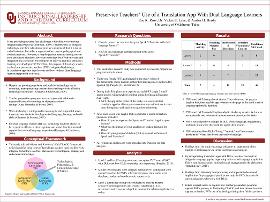| dc.description.abstract | BACKGROUND: Many practicing teachers face challenges with effective technology integration (Keengwe & Onchwari, 2009). Teachers who do integrate technology into their educational practices understand that it is not an end-all solution, but rather a support to their current pedagogical and content practices. However, a simple question remains among current early childhood educators, how can technology be effectively used and integrated into classroom environments in order to facilitate children’s learning and development? Therefore, the purpose of this study was to explore how pre-service teachers (PSTs) integrated technology (a translation app) into their lessons and how students (or dual language learners) responded to the use of this technology. The study was guided by the following research questions:
1. How do pre-service teachers integrate Speak & Translate with dual language learners?
2. Based on PST's observations, how do dual language learners respond to the use of Speak & Translate?
METHODS: This qualitative, phenomenological research study was conducted in a teacher preparation program in the Midwest. Thirty-one female PSTs participated in the study. During their field placement experience, each PST taught 3 small group lessons with preschool children using the Speak & Translate (S&T) app. After each lesson was taught, PSTs completed a lesson reflection that was uploaded into Dedoose. Analysis included level 1 (priori coding) and level 2 (thematic coding) in order to analyze the reflections and explore PST’s use of S&T with DLLs and how DLLs responded to this experience.
RESULTS: Across all lessons, S&T was utilized a total of 46 times and was primarily used to translate key vocabulary of the lesson or content of the book. PSTs also used the app to model an activity, model material use, and provide instructions and directions. The most exciting finding was the changes PST’s noticed in DLL’s body language, engagement, and motivation when they used the app in their lessons.
CONCLUSION: PSTs were asked to focus on the integration of technology (S&T), which produced a lesson that met all aspects of the TPACK framework. Based on PST’s reflections, they not only experienced a shift in their own thinking and pedagogical approaches, but they also noticed a shift in DLLs’ engagement and motivation during their technology supported lessons. Findings from this study hold promising and important educational implications for pedagogical practices not only for PSTs, but also for current educators who work with DLLs. | en_US |

